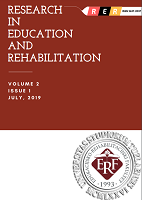VISUAL PERCEPTION IN CHILDREN WITH MILD INTELLECTUAL DISABILITIES
VISUAL PERCEPTION IN CHILDREN WITH MILD INTELLECTUAL DISABILITIES
Author(s): Hurma Begić Jahić, Medina Vantić-Tanjić, Amela Teskeredžić, Dženana Radžo AlibegovićSubject(s): Preschool education, Health and medicine and law
Published by: Edukacijsko-rehabilitacijski fakultet Univerziteta u Tuzli
Keywords: students with mild intellectual disabilities; visual perception; preschool education;
Summary/Abstract: Visual impairment is a major problem for every individual, considering that visual information makes up about 90% of the data arriving into the cerebral cortex via all human sensory organs. The human learns through visual imitation, which is why it is very important having good visual perception to facilitate overall development. The aim of this study is to examine the level of school competence/readiness of students with mild intellectual disabilities, and to determine whether there are differences in visual perception abilities between students with mild intellectual disabilities who attended preschool education and students with mild intellectual disabilities who did not attend preschool education. The study was conducted on a sample of 60 students with mild intellectual disabilities, both genders were included, first graders and second graders. The sample of respondents was divided into two sub-samples: students with mild intellectual disabilities who attended preschool education (N = 25) and students with mild intellectual disabilities who did not attend preschool education (N = 35). The study was conducted using the DABERON-2 test (Danzer, Frances, Gerber, Lyons, Voress, 1991). The test was designed to test ten areas, but for the purposes of this research, a part of the test related to visual perception area testing was isolated, and this part involves examining visual perception through the ability to map the same figures. The maximum number of points that can be achieved in this area is 10. The results were presented by descriptive statistics, and the differences between the respondents were calculated by t-test. On the summary variable of the "Visual Perception" area, students with mild intellectual disabilities who did not attend preschool education achieved an average score of 7.37, with a standard deviation of 2.43, while the other group of students with the same disabilities, who attended preschool education, achieved an average score of 5.84 with a standard deviation of 3.09. The results of the t-test did not show a statistically significant difference in the level of school competence/readiness of students with mild intellectual disabilities in relation to the attendance of preschool education; in the area of "Visual Perception" (t= -2,144; p= 0,169).
Journal: Research in Education and Rehabilitation
- Issue Year: 2/2019
- Issue No: 1
- Page Range: 30-37
- Page Count: 8
- Language: English

